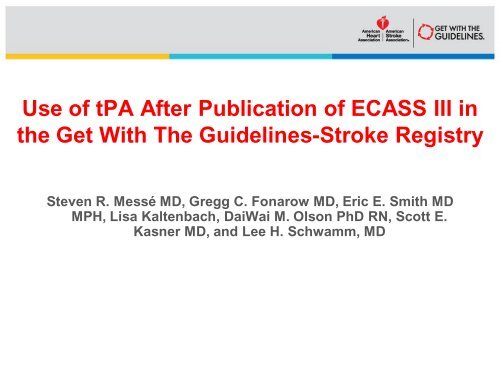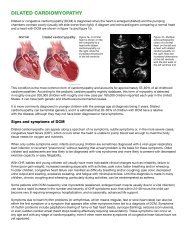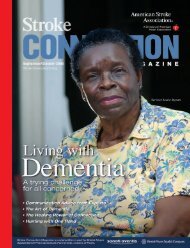Use of tPA After Publication of ECASS III - American Stroke ...
Use of tPA After Publication of ECASS III - American Stroke ...
Use of tPA After Publication of ECASS III - American Stroke ...
Create successful ePaper yourself
Turn your PDF publications into a flip-book with our unique Google optimized e-Paper software.
<strong>Use</strong> <strong>of</strong> <strong>tPA</strong> <strong>After</strong> <strong>Publication</strong> <strong>of</strong> <strong>ECASS</strong> <strong>III</strong> in<br />
the Get With The Guidelines-<strong>Stroke</strong> Registry<br />
Steven R. Messé MD, Gregg C. Fonarow MD, Eric E. Smith MD<br />
MPH, Lisa Kaltenbach, DaiWai M. Olson PhD RN, Scott E.<br />
Kasner MD, and Lee H. Schwamm, MD
Presenter Disclosure Information<br />
Steven Messé, MD<br />
Research Grant; NIH (modest).<br />
Speakers bureau; Boehringer-Ingelheim (modest).<br />
The Get With The Guidelines®–<strong>Stroke</strong> (GWTG-<strong>Stroke</strong>) program is provided by the<br />
DISCLOSURE INFORMATION:<br />
<strong>American</strong> Heart Association/<strong>American</strong> <strong>Stroke</strong> Association. The GWTG-<strong>Stroke</strong><br />
Program is currently supported in part by a charitable contribution from Ortho-<br />
McNeil. GWTG-<strong>Stroke</strong> has been funded in the past through support from<br />
Boeringher-Ingelheim, Merck, Bristol-Myers Squib/San<strong>of</strong>i Pharmaceutical<br />
Partnership, and the AHA Pharmaceutical Roundtable.
Background<br />
• The NINDS r<strong>tPA</strong> <strong>Stroke</strong> Study established that <strong>tPA</strong><br />
given within 3 hours <strong>of</strong> acute ischemic stroke (AIS)<br />
improves the likelihood <strong>of</strong> good outcome.<br />
– Only a small percentage <strong>of</strong> AIS patients receive this<br />
medication<br />
• In September 2008, <strong>ECASS</strong> <strong>III</strong> demonstrated that<br />
<strong>tPA</strong> given within 3 to 4.5 hours <strong>of</strong> AIS provides a<br />
more modest but still clinically meaningful<br />
improvement in outcome.<br />
NEJM. 1995;333(24):1581-1587.<br />
NEJM. 2008;359(13):1317-1329.
Background<br />
• The <strong>American</strong> Heart Association subsequently<br />
published a Science Advisory in May 2009<br />
recommending treatment <strong>of</strong> eligible AIS patients<br />
up to 4.5 hours from onset <strong>of</strong> symptoms.<br />
• It remains uncertain what impact the publication <strong>of</strong><br />
<strong>ECASS</strong> <strong>III</strong> has had on the utilization <strong>of</strong> <strong>tPA</strong> in<br />
clinical practice in the United States.<br />
– Did <strong>tPA</strong> use increase?<br />
– Did door-to-needle times increase?<br />
<strong>Stroke</strong>. 2009;40(8):2945-2948.
Background<br />
• The <strong>American</strong> Heart Association Get With<br />
The Guidelines <strong>Stroke</strong> (GWTG-<strong>Stroke</strong>)<br />
registry is a national quality improvement<br />
initiative and database that includes data<br />
from over 1,000,000 AIS patients treated at<br />
~1,500 hospitals throughout the United<br />
States.
Methods
Methods<br />
• We queried the GWTG-<strong>Stroke</strong> dataset to<br />
identify AIS patients eligible for <strong>tPA</strong><br />
treatment<br />
• Patients with in-hospital stroke and those<br />
who received IV <strong>tPA</strong> at an outside hospital<br />
were excluded.<br />
• The primary outcome <strong>of</strong> interest was the<br />
proportion <strong>of</strong> eligible AIS patients who<br />
presented within 3.5 hours and received <strong>tPA</strong><br />
by 4.5 hours.
Methods<br />
• We compared clinical, demographic, and<br />
outcome measures for patients treated in the<br />
3 to 4.5 hour window, dichotomized by preor<br />
post-<strong>ECASS</strong> <strong>III</strong>.<br />
• We also evaluated the impact <strong>of</strong> <strong>ECASS</strong> <strong>III</strong><br />
on patients treated within 3 hours
Results
Results<br />
• We analyzed 600,538 AIS patients admitted<br />
to 1,465 hospitals between April, 2003 –<br />
April, 2010<br />
– 389,748 prior to and 210,790 after the print<br />
publication <strong>of</strong> <strong>ECASS</strong> <strong>III</strong> on September 25, 2008.<br />
– 102,961 presented within 3.5 hours and were<br />
eligible for <strong>tPA</strong> prior to <strong>ECASS</strong> <strong>III</strong> and 52,861<br />
after
Among Patients Treated 3 to 4.5 Hours<br />
• The proportion <strong>of</strong> eligible AIS patients who<br />
presented within 3.5 hours and were<br />
treated within 4.5 hours increased after<br />
<strong>ECASS</strong> <strong>III</strong><br />
– 18.8% vs. 27.7%, P
Among Patients Treated 3 to 4.5 Hours<br />
<strong>ECASS</strong> <strong>III</strong><br />
September, 2008<br />
AHA Advisory<br />
May, 2009
Among Patients Treated 3 to 4.5 Hours<br />
<strong>After</strong> <strong>ECASS</strong> <strong>III</strong><br />
– Onset-to-hospital-arrival time was longer<br />
� 90 (60 – 121) vs 112 (75 -144) min, P
Among Patients Treated 3 to 4.5 Hours<br />
Door-to-needle time did not vary by onsetto-treatment<br />
time<br />
Onset-to-treatment time Door-to-needle time<br />
3 - 3.5 hours 101 (70 - 132)<br />
3.5 - 4 hours 106 (73 - 146)<br />
4 - 4.5 hours 105 (75 - 149)
Among Patients Treated 3 to 4.5 Hours<br />
Pre-<strong>ECASS</strong> <strong>III</strong><br />
N=1478<br />
Post-<strong>ECASS</strong> <strong>III</strong><br />
N=1806 P<br />
Age* 72 (59 – 81) 70 (58 – 81) 0.36<br />
Female 50.1 % 49.7 % 0.80<br />
White 75.0 % 72.1 % 0.07<br />
HTN 75.8% 79.1% 0.03<br />
DM 29.3% 26.6% 0.10<br />
Initial NIHSS* 11 (7 – 17) 10 (6 – 17) 0.005
Among Patients Treated 3 to 4.5 Hours<br />
Pre-<strong>ECASS</strong> <strong>III</strong> Post-<strong>ECASS</strong> <strong>III</strong><br />
N=1478<br />
N=1806 P<br />
Symptomatic ICH<br />
(NINDS)<br />
7.3% 5.4% 0.01<br />
Length <strong>of</strong> stay,<br />
days*<br />
5 (3 – 9) 5 (3-7)
Patients Treated Within 3 hours
Patients Treated Within 3 Hours<br />
• The proportion <strong>of</strong> eligible AIS patients<br />
presenting within 2 hours and treated<br />
within 3 hours increased after <strong>ECASS</strong> <strong>III</strong><br />
– 56% vs. 72%, P
Among Patients Treated Within 3 Hours<br />
• <strong>After</strong> publication <strong>of</strong> <strong>ECASS</strong> <strong>III</strong><br />
– Onset-to-hospital-arrival time was unchanged<br />
� 50 (IQR 35 – 70) vs 51 (IQR 36 – 72)<br />
– Door-to-needle times decreased<br />
� 79 (IQR 60 – 100) vs 75 (IQR 58 – 98) minutes<br />
– Onset-to-needle time was similar<br />
� 138 (IQR 113 – 160) vs 136 (110 – 160)
TPA <strong>Use</strong> Over Time
Limitations<br />
• Data were collected by medical chart review<br />
• Residual measured and unmeasured confounding<br />
variables may have influenced the findings.<br />
• Hospitals that participate in GWTG-<strong>Stroke</strong> have an<br />
inherent interest in improving stroke care<br />
• The longer term impact <strong>of</strong> <strong>ECASS</strong> <strong>III</strong> remains<br />
uncertain
Conclusions
Conclusions<br />
• An increased percentage <strong>of</strong> eligible patients<br />
have received <strong>tPA</strong> since the publication <strong>of</strong><br />
<strong>ECASS</strong> <strong>III</strong><br />
– both in the 3 hour window and, to a greater extent, the 3 to<br />
4.5 hour window<br />
• The increased use and expanded time<br />
window has come without negatively<br />
impacting patients treated in < 3 hours.
Conclusions<br />
• These results are similar to what was<br />
reported by the SITS-ISTR assessment <strong>of</strong><br />
<strong>tPA</strong> utilization in Europe<br />
– <strong>tPA</strong> use expanded in both time windows after<br />
<strong>ECASS</strong> <strong>III</strong><br />
Ahmed et al. Lancet Neurol. 2010;9(9):866-874.
Conclusions<br />
• Overall, treatment rates <strong>of</strong> eligible patients<br />
in the 3 to 4.5 hour time window are still<br />
low and additional education efforts should<br />
be made to alert clinicians to the potential<br />
for treatment in the expanded window.<br />
• Median door-to-needle times are greater<br />
than the recommended 60 minutes
Questions?







